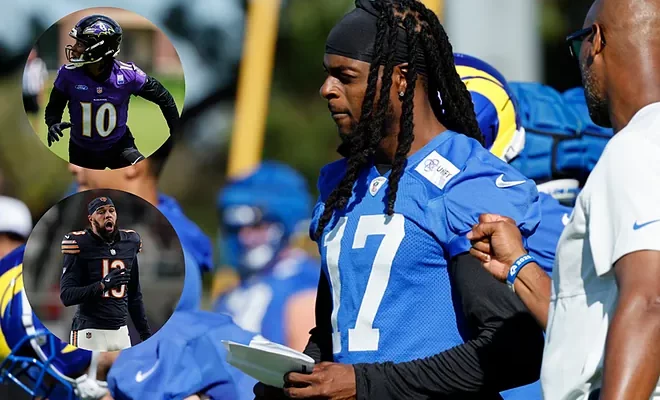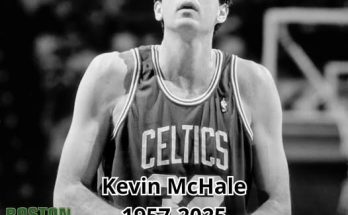Davante Adams, widely regarded as one of the most dominant wide receivers of the past decade, is now stepping into an entirely new challenge as he joins the Los Angeles Rams. After years of elite production in Green Bay and a tumultuous yet statistically rich tenure in Las Vegas, Adams finds himself wearing a new uniform, working within a new offensive system, and shouldering expectations that could significantly shape the Rams’ postseason hopes. For a player who’s used to being the centerpiece of an offense, the transition may test his adaptability, but it could also rejuvenate a Rams team that has struggled to find consistent explosiveness since their 2021 Super Bowl run.
Adams arrives in Los Angeles at a time when the Rams are actively trying to reconstruct their identity. With veterans like Aaron Donald having retired and Matthew Stafford’s long-term health still uncertain, the team is undergoing a partial rebuild while refusing to use that term publicly. The Rams are attempting to walk the tightrope of staying competitive while developing young talent, and adding a weapon like Adams is as much a signal of their playoff intentions as it is a move to anchor the receiving corps. With Cooper Kupp and Puka Nacua already entrenched as critical components of the passing game, Adams’ arrival adds a new dimension—one that defenses will have to reckon with on every snap.
The trade that brought Adams to Los Angeles sent shockwaves across the league. While there had been rumors that the Raiders might look to offload the star wideout amid their own restructuring efforts, few expected a deal to materialize with a team like the Rams. Los Angeles has been known for its aggressive, win-now mentality under head coach Sean McVay and general manager Les Snead, but many assumed the franchise had pivoted to a more fiscally conservative and developmental approach after parting ways with several high-priced veterans. Yet in bringing in Adams, the Rams reaffirmed their belief that stars still matter—and perhaps more importantly, that the NFC is winnable with the right mix of veteran leadership and young talent.
For Adams, the move to L.A. represents an opportunity to remind the football world just how dangerous he can be. Despite the Raiders’ struggles, he managed to put up over 1,100 receiving yards last season and remained one of the most targeted players in the NFL. His route-running remains surgical, his hands are elite, and his ability to manipulate coverages continues to be among the league’s best. What was often missing in Las Vegas was consistency at quarterback, organizational direction, and play-calling that could leverage his full capabilities. In McVay, Adams is now working with one of the most innovative offensive minds in the league—someone who will undoubtedly find ways to scheme him open and maximize his skill set.
The quarterback situation in Los Angeles adds intrigue to the equation. Matthew Stafford remains the presumptive starter, but his body has taken a beating over the years, and it’s not certain how many games he can endure at full strength. If Stafford is healthy, Adams could be in for a monster season. The veteran QB has never had a wide receiver with Adams’ precise route-running and physicality, even during his best years with Calvin Johnson. The chemistry between the two will be one of the most scrutinized storylines during training camp and the preseason. Should Stafford falter or miss time, the Rams would likely turn to young backups, which could impact Adams’ numbers but would also test his leadership.
Leadership is an area where Adams is expected to have an immediate impact. Though known primarily for his on-field prowess, Adams has long been respected for his work ethic, competitive fire, and locker room presence. In Green Bay, he often set the tone for a group that prided itself on precision and professionalism. In Las Vegas, he attempted to be a stabilizing force amid coaching changes and quarterback turnover. With the Rams, he’s joining a team that is still trying to define its next era. Players like Kupp and Nacua will undoubtedly benefit from Adams’ experience, and his presence may also accelerate the development of young players who are still learning how to prepare and perform at a high level.
One of the biggest questions surrounding Adams’ integration into the Rams’ offense is how McVay will balance the targets between three elite receivers. Cooper Kupp, when healthy, is a volume machine who thrives on quick routes, option reads, and rhythm-based throws. Puka Nacua emerged last season as a big-play threat and a physical receiver who can win on the outside and over the middle. Adams, meanwhile, can do it all—beat man coverage, dominate in the red zone, and create separation against the league’s best corners. Managing touches and maintaining chemistry between all three will be an ongoing challenge, but it’s one that McVay seems eager to embrace. He has long emphasized the importance of “positionless football,” and with these three weapons, he now has the flexibility to attack defenses from every conceivable angle.
The pressure, however, will be intense. Adams was not brought to Los Angeles to simply produce numbers—he was acquired to help win games and return the Rams to postseason relevance. In the NFC West, that’s no easy feat. The 49ers remain one of the conference’s elite squads, while the Seahawks and Cardinals are also making significant strides. Every division game will be a battle, and the margin for error is razor-thin. The Rams will need Adams to be both a security blanket and a game-breaker. That means converting on third downs, making contested catches in traffic, and turning short passes into long gains. It also means taking over when games hang in the balance—something Adams has done countless times throughout his career.
Adams’ arrival also signals that the Rams are not satisfied with mediocrity. After winning the Super Bowl just a few seasons ago, they endured a sharp decline due to injuries, cap constraints, and roster turnover. Yet unlike some franchises that would sink into a full rebuild, the Rams are choosing to reload selectively, betting on high-end talent to stabilize the team while the next generation develops. Adams fits into that philosophy perfectly. He brings All-Pro capability with none of the off-field drama, and he provides a bridge between the past and future.
For Adams himself, the move to Los Angeles comes at a personal crossroads. At 31, he’s aware that he’s now entering the back end of his prime. He’s accomplished almost everything a wide receiver can hope to achieve—Pro Bowl selections, All-Pro honors, and league-wide respect. What has eluded him, however, is a Super Bowl ring. That quest is what drives so many veterans in the later stages of their career, and it’s likely at the forefront of Adams’ mind as he puts on a Rams jersey for the first time. He’s no longer trying to prove he belongs in the NFL; he’s trying to add the one missing piece to an otherwise stellar legacy.
The upcoming season will offer a fascinating glimpse into whether this bold move pays off. If Adams, Stafford, and McVay can align their vision and execution, the Rams could return to being a legitimate threat in the NFC. If injuries or chemistry issues derail their plans, the move will be second-guessed in every sports media cycle. But no one questions that Adams still has plenty of football left in him. His skills have not diminished, and his desire to compete at the highest level burns as hot as ever. In a league where elite receivers can tilt the balance of power, Davante Adams may once again prove to be the difference-maker—only this time, in the City of Angels.



